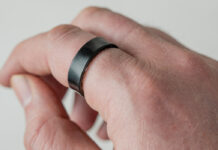The past six months have been a little hectic around my place. With my twins turning 13, we now have three teenagers running around the house. We went through a long, expensive, and stressful episode that ended with losing a much loved family pet. And much of the house is upside down for renovations. So I suppose it wasn’t surprising that at the last checkup with my doctor, she discovered my blood pressure was higher than usual. She suggested buying a blood pressure monitor to track it on a daily basis.
I’m a “if you get lemons, make lemon aid” kind of guy. I’m also really into health and fitness tracking technology. So naturally, I turned the situation into an opportunity to add to my collection of gadgets. Rather than choose a traditional home blood pressure monitor, I opted for the iHealth BP7 Bluetooth Blood Pressure Monitor. It’s comparable in price to other models — actually much less than I was expecting a device like this would cost — but has the advantage of using your mobile device and an app instead of a built in display. Besides making the device itself more compact (it literally fits in a hand) using the smarts and display on my iPhone means for a much more meaningful, real-time presentation of the data. It also integrates that data with my other health fitness tracking info, in my case using Apple’s Health app as the central point of access.
iHealth BP7 Key Specs
|
The iHealth BP7 Is Not a Toy
When it comes to measuring a key vital sign like blood pressure, any device sold to do the job has to meet strict medical compliancy codes. The iHealth BP7 received FDA approval in the United States and Health Canada approval here at home. Obviously, you can’t expect to get the same accuracy as a machine you’d find in the hospital would deliver, but the iHealth BP7 is rated to come pretty close. I had a reading done by my doctor a few days before the BP7 arrived and the Bluetooth monitor was spot on compared to her reading.
To me, that’s pretty amazing for a device I can pick up on the shelf of my local Best Buy, use at home and carry in case that will fit in a coat pocket.
Setup
Setting up the iHealth BP7 Bluetooth Blood Pressure Monitor isn’t a whole lot different from setting up any other Bluetooth device. Essentially, you pop it out of the carrying case, plug it in to a free USB port until it’s charged, then pair it with your mobile device.
In this case, the next step is to download the free iHealth myVitals app (for iOS and Android). When it’s first launched, you’ll be asked to set up an account with iHealth, enter some basic personal information (like your height, weight, age and sex) and then you’re good to go. Push the power button on the BP7 and a Blue LED light on the sensor will flash until it’s paired with a device, then turn solid blue. At this point, the myVitals app launches and you’re ready to take a reading.
iHealth BP7 in Use
Using the iHealth BP7 Bluetooth Blood Pressure Monitor is dead easy and dare I say a little cool. Instead of the big cuff on the upper arm you’re probably accustomed to, the lightweight BP7 straps to your wrist using a comfortable, velcro-fastened cuff. The myVitals app coaches you if your arm isn’t at the correct angle for a proper reading (the included travel case is suggested as a prop and works quite well), and when you press the Start button, the magic happens.
Somehow iHealth has hidden the mechanics needed to inflate the cuff with the needed pressure inside this tiny package. I’ve been using it for three weeks and I’m still fascinated by how well that works. You can see the progress onscreen and when it’s done, it quickly deflates. The whole process takes only a minute or so. In fact, it was so easy I had to shoot this quick video that shows a reading in its entirety including actually putting on the BP7. And yes, you can see from the display on my iPhone that I have to work on my blood pressure. That’s why I got this thing, right?
I should also mention the BP7 can be used without your smartphone, and you can upload the results when you’re able to connect.

The iHealth myVitals app is actually considerably more than a control panel for the BP7 blood pressure monitor. It tracks your blood pressure and heart rate readings and graphs them over time, superimposes a single reading over a chart that shows exactly where it falls within the blood pressures spectrum and lets you add notes or quickly tag a reading with common activities such as eating for further analysis. It also shows the BP7’s current battery level.
There are also additional functions such as daily food diary and the ability to set targets, but I use other apps for those functions. Instead, I shared the blood pressure reading with Apple’s Health app. You can also e-mail results directly to someone (presumably your doctor).
The One Complication: Multiple Users
The only frustration I’ve run into with the iHealth BP7 is multiple users. My wife and I are both using it and, like typical Bluetooth devices, you can pair it with an unlimited number of devices — one at a time. The problem is the BP7 wasn’t great at releasing a connection, so if I used it, turned it off and then my wife powered it up and went to use it, it would automatically pair with my phone, not hers. There was supposed to be a setting for that, but I can’t find it in the app or at the system level. You can also set up multiple users in the app itself, but that’s not good if each wants to share their data with apps on their own devices.
The solution is to turn off Bluetooth on a device, turn off the iHealth BP7, then flip Bluetooth back on. It works, but it’s a little annoying.
Overall, though, I thought the iHealth BP7 Bluetooth Blood Pressure Monitor was a great addition to my growing collection of health and fitness trackers. For anyone who is concerned about blood pressure, it’s a great option for taking control of monitoring and far more convenient than having to go to the pharmacy whenever you want a reading.





